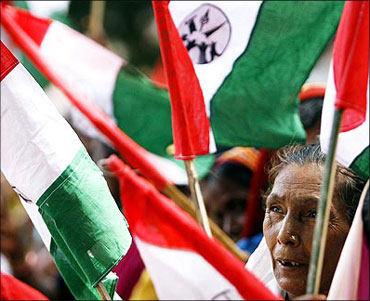
There is something odd about India's export numbers.
While the government focuses month after month on the rapid growth in exports (on the 2009 base and on the 2008 base, the 2010 numbers continue to show that exports have shrunk), the even greater success story that has been reported is the doubling and more of exports from the new special economic zones.
Exports from 111 such zones totalled $49 billion in 2009-10, up 123 per cent from the $22 billion earned in the previous year.
Some of this very rapid growth would be on account of the fact that the zones are still in the process of getting up and running.
What is odd, therefore, is not the export figure for the zones but that for the rest of the country.
Total exports last year, at $176 billion, were about 5 per cent lower than in the previous year.
If you take out the SEZ numbers for the two years, then non-SEZ exports fell from $163 billion to $127 billion -- a sharp drop of 22 per cent.
Click NEXT to read further. . .

Two explanations are possible. The first is that export performance outside of the SEZs, in the domestic tariff area, has been pretty disastrous; it is hard to recall any previous year in which exports fell by anything remotely like 22 per cent.
Indeed, non-SEZ exports in 2009-10 were at the same level as three years earlier ($129 billion in 2006-07).
The law on SEZs was passed in 2005, and it took a while for the government to start clearing the zones after the controversy over land acquisition and related issues.
It was only after this that the zones could start functioning.
So, it is safe to assume that hardly any of the exports that took place in 2006-07 would have been from the SEZs.
The alternative explanation would be that the surge in SEZ exports points to diversion of trade from the DTA to the SEZs -- something that policy is supposed to prevent.
If there is such diversion taking place, then the country is not gaining much on the export front, in terms of additional dollars earned, while the government is losing tax revenue.
Click NEXT to read further. . .

The issue gains new currency because proponents of the draft direct taxes code have argued that the continuation of tax exemptions for SEZ units would undermine the effectiveness of the new direct tax laws.
Defenders of the SEZ scheme, on the other hand, point out that the cost of preventing the exports sector from a virtual collapse in 2009-10 was a paltry Rs 5,200 crore (Rs 52 billion) by way of income-tax revenues, and Rs 3,200 crore (Rs 32 billion) of indirect tax revenues, which is what the government lost on account of the tax concessions given to SEZ units.
If the numbers are correct (the total cost being less than $2 billion), then the argument would be in favour of the SEZs.
But that does not take away the urgent need for the government to undertake a detailed examination of what is the real additionality achieved in exports through the SEZs.
If the bulk of such exports are, in fact, not a result of diversion from the DTA, the country faces a serious export challenge in the DTA that the over-all export numbers mask.